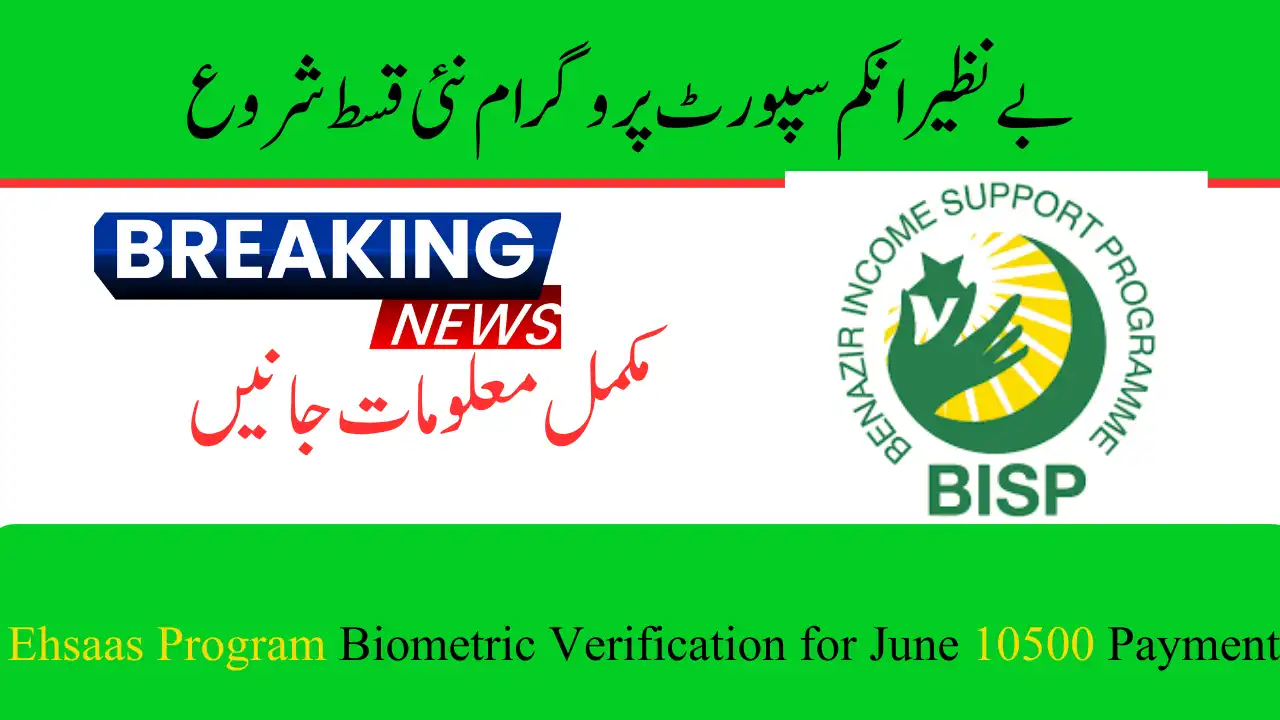Ehsaas Program Biometric Verification for June
The Ehsaas Program in Pakistan aims to provide crucial financial support to deserving individuals, yet many women have encountered challenges in receiving their payments due to issues with fingerprint verification. This problem has been particularly prevalent under the Benazir Income Support Programmed (BISP), prompting the introduction of a new process to address these concerns. This initiative allows beneficiaries to receive their payments without the need for fingerprint verification.
How to Receive Your Ehsaas Program Payment Without Fingerprint Verification
If you’re facing issues with fingerprint verification under the Ehsaas Program, follow these steps to ensure a smooth payment process:
Step-by-Step Procedure
- Visit Payment Centers
- Attempt to verify your fingerprints at designated payment centers. You have up to eight attempts to do so.
- NADRA Office Visit
- If verification fails at payment centers, visit your nearest NADRA office to attempt verification again.
- Family Member’s ID Card
- If NADRA verification also fails, accompany a family member with their ID card to the nearest BISP office.
- File a Complaint
- At the BISP office, file a complaint detailing the issues faced with fingerprint verification and request for payment without verification.
- Application Review
- BISP will review your application. You will receive notification of approval via SMS from 8171 or a call from the BISP office.
Big News: Also read: BISP Document Verification By NSER Dynamic Survey

For Beneficiaries in Different Regions
- Islamabad, Punjab, Sindh, and Balochistan
- Upon approval notification, visit the specified Habib Bank branch with your family member’s ID card to complete the verification process.
- KPK, Gilgit-Baltistan, and Azad Jammu and Kashmir
- Upon notification, revisit the BISP office where a Bank Alfalah representative will assist in the verification process. This involves entering your ID card number and receiving a verification code on your registered mobile number.
Troubleshooting
What to do if…
- Fingerprint Verification Fails at Payment Center: Visit other payment centers or follow the procedure above for alternative verification methods.
- You Don’t Receive a Notification: Ensure your contact details are correct and revisit the BISP office for further assistance if necessary.
Important Guidelines
- Persistence Pays Off: Try different payment centers and follow up diligently if initial verification fails.
- Use NADRA Services: Utilize NADRA offices for enhanced verification attempts.
- Involve Family Members: Bring a family member along with their ID card when required for additional verification steps.
- Stay Informed: Regularly check for notifications and updates regarding your application status.
Quick Details Table
| Action | Description |
| Visit Payment Centers | Attempt fingerprint verification up to 8 times at designated centers. |
| Visit NADRA Office | Utilize NADRA services if verification fails at payment centers. |
| Family Member’s ID Card | Accompany a family member with an ID card for further verification processes. |
| File a Complaint | Lodge a complaint at the BISP office if fingerprint verification fails repeatedly. |
| Approval Notification | Await SMS or call notification confirming payment approval. |
| Visit Specified Bank Branch | Complete verification at designated bank branches (for certain regions). |
| Visit BISP Office Again | Finalize verification process at BISP office with assistance from Bank Alfalah. |
You can Also Read: BISP Dynamic Survey Registration Procedure For New Families
Q&A
Q: Why is fingerprint verification necessary in the Ehsaas Program?
A: Fingerprint verification serves as a security measure to ensure that payments reach the rightful beneficiaries and to prevent misuse or fraud in the distribution process.
Q: What are the common reasons for fingerprint verification failure? A: Verification failures can occur due to technical issues with biometric scanners, mismatches in fingerprints, or inadequate training of staff operating the verification systems.
Q: How does the alternative verification process work?
A: If beneficiaries encounter issues with fingerprint verification at payment centers, they can visit their nearest NADRA office for re-verification. If this also fails, they can proceed with a family member to the BISP office to lodge a formal complaint and opt for payment without further fingerprint verification.
Q: What steps should beneficiaries take if they face verification challenges?
A: Beneficiaries should first attempt verification at payment centers. If unsuccessful, they should visit a NADRA office and then proceed to the BISP office with a family member if needed. Lodging a formal complaint at the BISP office ensures their case is reviewed promptly.
Q: How will beneficiaries know if their alternative verification request is approved?
A: Beneficiaries will receive an approval notification via SMS from 8171 or a call from the BISP office confirming the approval of their request for payment without fingerprint verification.
Impact and Benefits
The introduction of alternative verification methods marks a significant stride towards enhancing accessibility and inclusivity within the Ehsaas Program. By offering solutions to common verification challenges, the program ensures that eligible beneficiaries receive their entitlements without undue delays or bureaucratic hurdles
Conclusion
The initiative to facilitate Ehsaas Program payments without fingerprint verification marks a significant improvement in ensuring equitable access to financial assistance for eligible women in Pakistan. By adhering to the outlined steps and guidelines, beneficiaries can navigate through verification challenges effectively. This approach underscores BISP’s commitment to supporting those in need and ensuring the smooth disbursement of financial aid. For any further assistance, beneficiaries are encouraged to contact their nearest BISP office promptly.
You
This article aims to provide clarity on recent developments in the Ehsaas Program while addressing common queries beneficiaries may have about the verification process.
